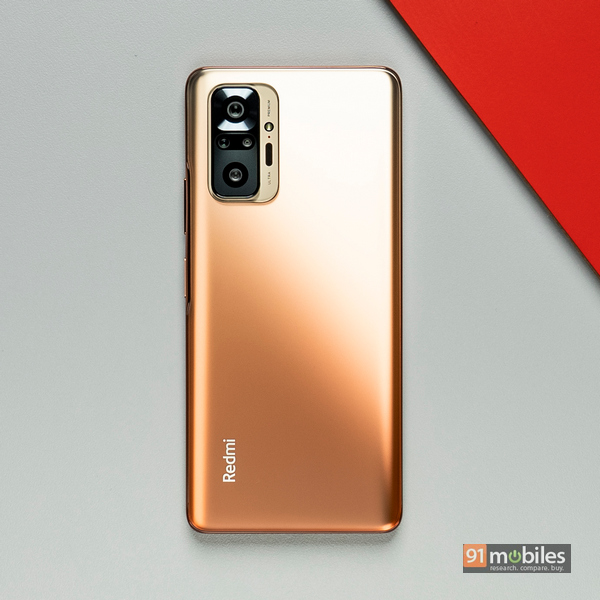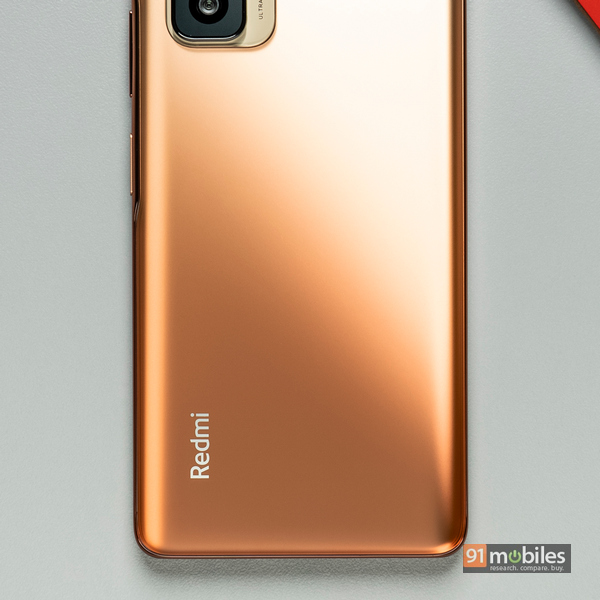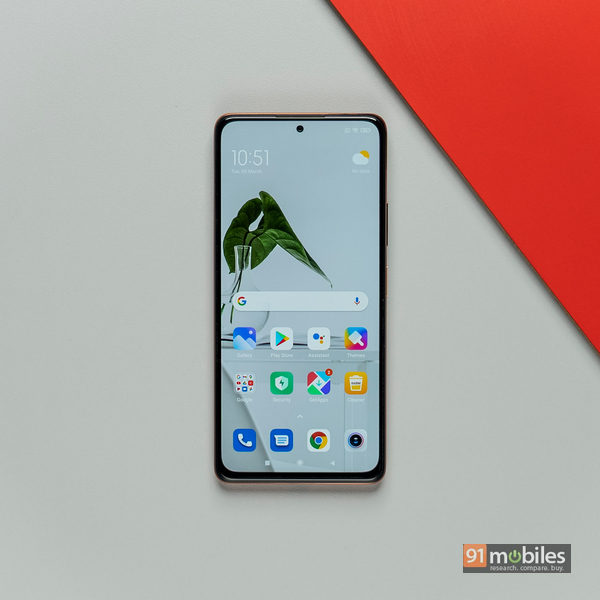Review Summary
Expert Rating
Xiaomi is the numero uno smartphone brand in the country, having made a name of itself on the premise of delivering quality products at reasonable prices. The brand managed to kickstart healthy competition amongst several smartphone makers, with the consumers reaping the benefits. A big chunk of the credit for Xiaomi’s success in the smartphone arena has to go to its popular Redmi Note series that basically disrupted the affordable segment. We have come a long way from the days when the company had a single Note smartphone in its portfolio to now when the lineup has three models. Xiaomi has just announced the Redmi Note 10 Pro Max, Note 10 Pro, and Note 10, the prices for which start from Rs 11,999 and go all the way up to Rs 21,999. It is clear that the Redmi Note series has evolved with the times and has started to venture into the mid-range segment. In this review, I will be dissecting the Redmi Note 10 Pro which starts at Rs 18,999. Is it worth buying this Redmi phone for the asking price? How does it fare against some of the competing phones such as the Realme X7 (review)? Read on to find out.

Table of Contents
Verdict
The Redmi Note 10 Pro Max, notwithstanding its ridiculously long name, is one of the finest phones you can find in its segment. The smartphone offers the best display, possibly the best camera, a decent battery, and reasonably good performance for its price. MIUI 12 does leave a little bit to be desired, but I do like the fact that Xiaomi has reduced bloatware drastically. The Note 10 Pro Max is undoubtedly the best Redmi Note series phone yet and I’m hoping I’ll be able to use the same statement to describe its successors, as and when they come.

Design
Right from the get-go, it’s clear that the Redmi Note 10 Pro Max has been designed to impress. The Note 10 Pro Max’s smooth frosted-matte finish combined with a glossy frame has won me over instantly. Xiaomi calls this the new EVOL Design, which is just love spelt backwards, and is present on all the Note series phones this year. This is the first time a glass back has been used on a Redmi Note device and it does add to the elegance of the device. I’m also a fan of the Dark Night colour scheme that delicately blends a deep black shade with hues of blue. The Vintage Bronze is a sheer delight to look at too. The in-hand feel is further amplified by how light the device is, even though it does pack in a big battery. Weighing in at 192g and being just 8.1mm thick, the Redmi Note 10 Pro Max is quite compact as compared to its counterparts.

The quad camera on the back gets a unique elongated housing with a sizeable primary sensor at the top and a trio of lenses below it, while the dual-LED flash module is present on the side. You can feel the sharp protrusion when you run a finger over the camera’s edges. Thankfully Xiaomi provides a well-fitting silicone case in the box that masks the sides, but on the downside, also hides the phone’s gleaming back under a translucent layer. The standard selection of ports and buttons can be seen on the Note 10 Pro Max. The USB-C port is at the bottom, along with a speaker grille which combines with the earpiece up top to offer stereo sound. The 3.5mm headphone jack is inconveniently placed at the top, but I guess I should be thankful that there is a jack at all. An IR Blaster also makes its way on the phone, and it is a very handy feature too, making the device a universal remote. The power button on the right is also a capacitive fingerprint sensor, while just above it is a tactile volume rocker.

Display
Xiaomi has made big changes to the screen on this year’s Redmi Note lineup. The Pro Max and Pro both get identical and exceptionally good FHD+ (2,400 x 1,080) Super AMOLED panels that are 6.67-inches in size. A standout feature that really sets the Note 10 Pro Max apart from its competition is the fact that you get 120Hz refresh rate on the AMOLED panel. The protection given by Xiaomi is also quite robust with Corning’s Gorilla Glass 5 covering the screen. Apart from that, the display is HDR10 compliant and also claims a full 100 percent coverage on the DCI-P3 colour gamut. I have to say that under the Rs 20,000 price bracket, the Note 10 Pro Max offers the best viewing experience on a smartphone yet. The colour accuracy is quite good, with contrast ratios and temperatures maintained quite impressively across the spectrum of hues. Viewing HDR content on OTT platforms is an enjoyable experience. Full disclosure: my unit does not support Netflix in HDR right now but Xiaomi assures me that retail units will. Astonishingly the panel also boasts of 1200nits of peak brightness levels. Safe to say you shouldn’t have any issues with screen legibility even under harsh sunlight. The display customisation options available include settings to choose colour profiles, toggle the blue light filter, enable the always-on display, and more. There’s a monochromatic ink mode for comfortable reading too. Believe me when I say that the Note 10 Pro Max’s display is candy for the eye and it sets precedent for competing devices to offer flagship-level viewing quality in this price range.

Cameras
Most Redmi Note phones over the years have laid special emphasis on the cameras, especially on the number of pixels that can be crammed into a photo taken by the primary sensor. The Note 10 Pro Max’s 108MP primary camera, the first of its kind under Rs 20,000, is really a game-changer and not because it packs a higher megapixel count. The camera uses the new Samsung ISOCELL HM2 sensor that utilises nine-pixel binning technology which combines nine small 0.7μm pixels into one large 2.1μm pixel. This allows for more light to seep in and expose intricate details of a shot. The effect did seem immediately obvious when I took the Note 10 Pro Max out on a sunny day in my local park. As you can see in the shots below, the primary lens on the device captures stunning colours and tons of detail, whether it is the greenery of the trees or the blooming flowers on the side. The dynamic range across the shots is excellent and the sensor adjusts the exposure while retaining natural colours too. There is a slight oversaturation visible in the photos but colour temperatures are maintained quite well depending on the scenario. The shooters do a splendid job, accomplished by a good understanding of computational photography. There is, of course, the ability to click full-resolution 108MP shots instead of the normal 12MP pixel-binned shots, but unless you want to fill up the storage space on your device, I wouldn’t recommend it. As an example, a single JPEG picture taken in the 108MP mode is nearly 27MB in size.

A special mention has to be given to some of the best night-mode photography in this segment. The large sensor size is a big help in low light, bringing out lots of detail even in the shadows behind the subject and the outlines. However, sometimes you do get the odd lens flare when focusing on a bright source of light during the night with exposure being all over the place. The dedicated Night Mode comes to the rescue by reducing extra exposure and smoothening out noise while keeping the details intact.

Other sensors on the device include the 8MP ultra-wide sensor that has an affinity towards warmer colour tones but the 118-degree field of view captures a lot in the same frame without any distortions on the edges. The 5MP macro sensor has built-in 2X optical zoom telephoto capabilities, which I appreciate very much. It can capture regular macro shots with the subject being as close as 2cm and is one of the better sensors in terms of colour accuracy. The depth sensor fulfils its functionality of capturing great portrait shots with good edge detection. Overall, the shutter and focus speeds were very fast and the sensor can keep track of a moving object quite effectively while shooting a video. You can shoot in 4K @ 30fps, while in super-steady mode the quality is locked at 1080p @ 30fps. The selfie shooter on the device is a 16MP sensor that oversharpens faces and is not very good at matching skin tones. At night though, the selfie camera almost always managed to impress me.
Performance and software
Xiaomi has equipped the Redmi Note 10 Pro Max with the Snapdragon 732G chipset that is a step above the 720G on the predecessor. However, it is not as big a boost as I have come to expect from the Note series over the past couple of years. Looking at benchmarks, the numbers are decent. On Antutu, the device attained a score of 281,443 while on Geekbench, the single-core and multi-core scores logged were 564 and 1,725 respectively. For comparison’s sake the similarly-priced Realme X7, powered by the Dimensity 800U, had an Antutu score of 335,217 (which is about 17 percent faster). However, if you are planning to put the Redmi Note 10 Pro Max through a multitude of strenuous tasks, I can assure you that you will not be disappointed. This includes heavy multi-tasking and running processor-intensive games like Call of Duty Mobile. For the latter, you can play the title at the highest Graphics Quality but the Frame Rate option is going to be restricted to the Very High instead of Maximum. If you are expecting a big jump in performance from last year’s Redmi Note 9 Pro Max, then you might come out slightly disappointed. On the plus side, any processor-heavy task you could accomplish then can be done more easily now. The phone comes with 8GB RAM + 128GB storage options while the base variant starts at 6GB RAM + 64GB storage. There is no microSD card support, which is something that is present on competing Realme devices.

Let’s also talk about the lack of 5G on the Redmi Note 10 Pro Max and how that stands in the way of futureproofing. Looking from a consumer’s point of view though, rivals like Realme Narzo 30 Pro (review) and Realme X7 are 5G-enabled and that could be hard to ignore. However, there’s still no clear timeline on when we’ll get to use 5G in the country. Jio and Airtel have both promised that 5G rollout in India should begin sometime this year. In fact, Ookla (one of the most popular mobile network measuring services) has a map of 5G towers around the globe, which shows that Airtel and Jio have already set up towers in Mumbai and Hyderabad. It is just a matter of time before consumers start factoring in 5G capabilities as a possible metric for buying a smartphone, if they haven’t already. On the other hand, there’s still no news on when spectrum auctions will be held, and it’s clear that the 5G networks will take a while to penetrate the farthest reaches of our country. That isn’t likely to happen before next year, by which time I hope, the company would have some Redmi Note phones with 5G in its kitty. Whether the lack of 5G in the Redmi Note 10 Pro Max is a deal-breaker or not is something you’d need to figure out, but the fact is, the commercial availability of 5G is a ways away. But since the competition is offering 5G capabilities in this segment, I will count it as a negative for the Redmi. For now, I tested the Note 10 Pro Max on Jio’s 4G network in Noida and faced absolutely no problems.

As for other features on the device, you do get an incredibly fast and accurate fingerprint reader on the side which is accompanied by faster but less accurate face unlock. The IR blaster is quite handy as a remote when I’m too lazy to reach for an actual one. Also a word of appreciation for the splendid job done by Xiaomi on the hi-res certified stereo speakers that provide an incredible listening experience, and almost make up for the poor positioning of the 3.5mm headphone jack on the top.

Xiaomi’s MIUI platform has gotten some flak previously, though the interface has improved with each new iteration. For one, the Redmi Note devices ship with the new MIUI 12 based on Android 11, which puts them ahead of the Realme phones. Bloatware has been reduced considerably and the Google Feed integration on the side is a welcome change. However, I don’t like the lack of an app drawer by default since you need to go into the settings to enable it, but that’s just me. Even so, the one-handed use approach for the drop-down quick settings does work quite well for me. Also, I’m told that the MIUI 12.5 update will be available soon, and will allow the users to remove many of the pre-installed apps. So I’m hoping that the bloatware would soon be a thing of the past.

Battery
The Redmi Note 10 Pro Max packs in a sizeable 5,000mAh battery that supports 33W fast charging. What’s more, the charger is provided inside the box. I was quite impressed with the power management of the phone, the standby times in particular. In general, I have not had the phone run out on me during a full day of use, with my usage comprising some gaming and watching YouTube too. Screen-on-time was in the range of about six hours which is fine, to say the least, and the fast charging speeds will not let you feel the need for more. You can completely juice up the phone in about 80 minutes with half the battery charged in 30.

Final Verdict
With the Redmi Note 10 Pro Max, Xiaomi has made a smartphone that might not deliver in all aspects, but in those that really matter to the user. I’m a big fan of the display, which I will term as the best in its segment, hands down. The cameras are also a very big selling point for the phone, and that’s not just due to the fact that the phone can click 108MP shots but more about how good the photos turn out. Could performance have been just a shade better? Maybe. But the current range of Snapdragon 700 series chipsets supported by 6GB/8GB of DDR4X RAM pack enough grunt for getting through most tasks. On the plus side, are the incredible stereo speakers along with the very handy IR blaster. The ample battery life will last you for an entire day with the fast charging acting as the icing on the cake. Hopefully, MIUI will continue to improve with each new update, but the lack of 5G could dissuade some potential buyers, despite the non-availability of 5G networks. If you’re okay with that, there’s no doubt that the Redmi Note 10 Pro Max is a solid buy for its asking price, and one that I can wholeheartedly recommend.
Editor’s rating: 4 / 5
Pros
- Best-in-class display
- Cameras are excellent
- Good battery life
- Decent performance
Cons
- Misses out on 5G
 Xiaomi Redmi Note 10 Pro Max Xiaomi Redmi Note 10 Pro Max | vs |  realme X7 realme X7 |
 Xiaomi Redmi Note 10 Pro Max Xiaomi Redmi Note 10 Pro Max | vs |  Moto G 5G Moto G 5G |







































